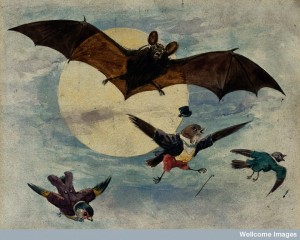As a nineteen year old university student, I find myself stressing over an infinite amount of things. I am a self-proclaimed worrier but something that rarely makes my list of worries is death.
However, in early Britain, the average life expectancy was forty years old[1] and 40% of people did not make it to adulthood[2]. As a result of such low life expectancies, death was a big concern to people of all ages. People accepted that it could arrive at any moment and so were vigilant in identifying signs that their impending death was looming.
After reading Stephen Wilson’s, The Magical Universe. Everyday rituals and magic in Pre-modern England, my lack of concern about death became interesting to me. Wilson describes death as ‘frequent, public and inescapable’, therefore it comes as no surprise that death and dying were given much more importance than they are now. Rituals were put in place to help the dying and after death there was still many procedures to be followed. These included ensuring that the feet of the corpse were facing the door and all mirrors were covered. This ensured that the spirit of the corpse would be able to find its way to the afterlife with minimal difficulties.
What intrigued me about Wilson’s novel is his mention on the signs of which predicted the occurrence of death. Today, unless told so by a healthcare professional (or google if I have decided to look up my symptoms), we are unlikely to go around predicting death. However, pre modern Europe, ‘death was never considered as a purely natural event’ it was seen as something that had magical and mystical dimensions and so could be announced by signs. Signs that are seen to indicate death today are often physical and behavioural changes that occur within the person about to die and are usually noticed whilst the person is in the process of dying. However, Wilson speaks of signs that can be noticed in all aspects of everyday life, from animals behaving abnormally to the disturbance of certain household objects. Interestingly, none of these signs have any medical origins and seem like random daily occurrences to the uninformed person. Nevertheless I decided to note down these signs and see if death was on the horizon for me.
A grave mistake:
I would like to say that the results of my observation allowed me to conclude that I had a long and fruitful life ahead of me, however, that is not what my experiment revealed to me at all.
On Monday, I woke up at 9am to get ready for my lecture, upon doing so I realised that a picture of my two younger brothers had fallen from the wall which I had stuck it on. The falling of a family portrait was the first sign of my untimely death.
On my way to my lectures I looked out for birds as the cry or appearance of certain bird’s signalled death. Except for a few pigeons, (which are only a sign of death if they appear and remain in the same spot until a death occurs), everything seemed okay.

On Tuesday night as I attempted to sleep I heard what may have been a dog howling at an unusual time. This was then followed by my sighting of a German shepherd being taken for a walk the following morning. This seems relatively normal unless you were aware that a dog running wildly was another sign that death was round the corner.
What I found as the week went by was that although I did not necessary believe these signs indicated my death, I began noticing them more in everyday life. When I saw a magpie, I was relieved that it didn’t make any noise because the call of a magpie would be another indication that my days were numbered. I was also thankful that I hadn’t sighted it knocking at my window because apart from that being quite strange, this was another of the many things I needed to look out for.
By Friday I was over-analysing everything and began inspecting my bed sheets for coffin-shaped creases just to reassure myself I wouldn’t be dropping dead soon. Of course, if you look at anything long enough it can begin to take on coffin shaped qualities and so the results of this were not helpful at all. When my boiler began making noises, I debated whether or not boilers counted as furniture because furniture emitting loud wraps would be another signal of my upcoming death. On Saturday I decided to stop my experiment when my glass fell off the counter and smashed without reason. I had concluded that by pre-modern Europe standards my life was hanging on a very thin thread.
Digging too deep:
During my week, I encountered a lot of things that would be considered signs of death in early Europe. However, there were many more I did not notice, for example I did not hear a chicken crowing like a rooster or premonitions of death-bed scenes. What I happened to notice were often things with little significance which I gave importance to by over analysing them and turning them into things that I was looking out for.
I believe that the high death rates of early modern Europe caused the same effect in people. Death was not as feared as it is now, people were very aware of their mortality. Although a lot of these signs seem absurd to us today, it may have been oddly comforting to feel as though you have some insight into something so unpredictable.
[1] https://ourworldindata.org/life-expectancy/
[2] http://www.localhistories.org/life.html
Wilson, S. “Death and the Dead” in The Magical Universe: Everyday Ritual and Magic in Pre-Modern Europe (London and New York: Hambledon and London, 2000).

[…] Supernatural & Natural Worlds in Early Modern Europe: Cursed by mortality: exploring the Pre-modern European attitudes to death […]
LikeLike